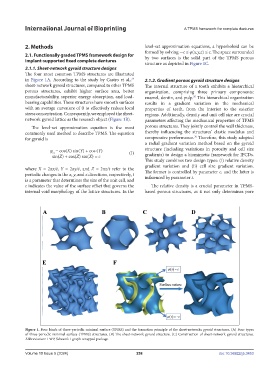Page 266 - IJB-10-5
P. 266
International Journal of Bioprinting A TPMS framework for complete dentures
2. Methods level-set approximation equations, a hyperboloid can be
formed by solving -c ≤ φ(x,y,z) ≤ c. The space surrounded
2.1. Functionally graded TPMS framework design for by two surfaces is the solid part of the TPMS porous
implant-supported fixed complete dentures
structure as depicted in Figure 1C.
2.1.1. Sheet-network gyroid structure designs
The four most common TPMS structures are illustrated
34
in Figure 1A. According to the study by Castro et al., 2.1.2. Gradient porous gyroid structure designs
sheet-network gyroid structures, compared to other TPMS The internal structure of a tooth exhibits a hierarchical
porous structures, exhibit higher surface area, better organization, comprising three primary components:
manufacturability, superior energy absorption, and load- enamel, dentin, and pulp. This hierarchical organization
35
bearing capabilities. These structures have smooth surfaces results in a gradient variation in the mechanical
with an average curvature of 0 to effectively reduce local properties of teeth, from the interior to the exterior
stress concentration. Consequently, we employed the sheet- regions. Additionally, density and unit cell size are crucial
network gyroid lattice as the research object (Figure 1B). parameters affecting the mechanical properties of TPMS
The level-set approximation equation is the most porous structures. They jointly control the wall thickness,
commonly used method to describe TPMS. The equation thereby influencing the structures’ elastic modulus and
36
for gyroid is compressive performance. Therefore, this study adopted
a radial gradient variation method based on the gyroid
φ = cos(X) sin(Y) + cos (Y) (I) structure (including variations in porosity and cell size
G
gradients) to design a biomimetic framework for IFCDs.
sin(Z) + cos(Z) sin(X) = c
This study combines two design types: (i) relative density
gradient variation and (ii) cell size gradient variation.
where X = 2πx/t, Y = 2πy/t, and Z = 2πz/t refer to the The former is controlled by parameter c, and the latter is
periodic changes in the x, y, and z directions, respectively, t influenced by parameter t.
is a parameter that determines the size of the unit cell, and
c indicates the value of the surface offset that governs the The relative density is a crucial parameter in TPMS-
internal void morphology of the lattice structures. In the based porous structures, as it not only determines pore
Figure 1. Four kinds of three-periodic minimal surface (TPMS) and the formation principle of the sheet-networks gyroid structures. (A) Four types
of three-periodic minimal surface (TPMS) structures. (B) The sheet-network gyroid structure. (C) Construction of sheet-network gyroid structures.
Abbreviation: I-WP, Schoen’s I-graph-wrapped package.
Volume 10 Issue 5 (2024) 258 doi: 10.36922/ijb.3453

